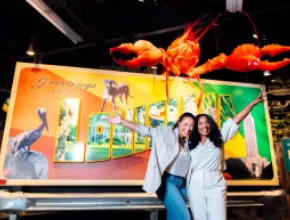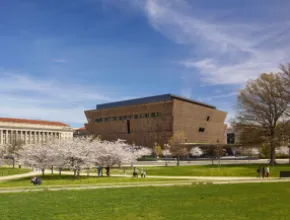Birthplace of jazz, cradle of Creole/zydeco and a musical mecca for modern artists like The Black Keys and Robert Plant, New Orleans sets the tempo for the rest of the country. There is literally music around every corner here. But then, “NOLA” has always been musically inclined, even before all that jazz began.
“The first opera in the New World was staged in New Orleans,” noted native son John McCusker, author, photographer, activist and tour guide.
In fact, that first performance, of Gretry’s Sylvain, was staged while George Washington was still president and the city was still under Spanish rule. The site of the old French Opera House, which burned down in 1919, is now where the Four Points by Sheraton French Quarter stands.
While opera and scores of other musical genres thrive here, the Crescent City is unquestionably identified with what is called “America’s original art form”—jazz—and the demigods who created it, including Louis Armstrong and Jelly Roll Morton, who are honored daily in the bars, clubs and sidewalks of fabled neighborhoods like Faubourg Marigny, Treme and the French Quarter.
“Immersing yourself in the music of New Orleans is a must for any visitor,” said Kristian Sonnier, vice president of communications and public relations for the New Orleans CVB. “Tours, clubs, museums … I’d recommend them all.”
Following are some specific ideas for your next event:
Cradle of Jazz Tour
504.487.7666
After snapping images of his hometown for more than 30 years, former The Times-Picayune photojournalist John McCusker is taking another look at New Orleans—through the lens of history, leading tours that trace the birth of jazz via the homes and haunts of Armstrong and Morton as well as pioneers like King Oliver and Edward “Kid” Ory (about whom McCusker wrote a biography, titled Creole Trombone).
McCusker’s Cradle of Jazz Tour takes about two hours and can be as intimate as four people in a van or a busload of up to 55.
“I take you to the ’hood, where the real music happened,” McCusker said. “We don’t just look at houses, we listen to the songs, so there’s a musicology to it. The music builds from the very earliest jazz, including an 1898 Edison cylinder of pre-jazz.”
The tour also includes a walk through the 32-acre Louis Armstrong Park and encompasses the city’s vibrant Afro-Creole culture.
“If you’re someone who lives and breathes this stuff, I can get inside the baseball with you, or for the casual tourist, I can keep it general,” McCusker said. “You’re going to hear passion, you’re going to hear feeling. I put people in the driver’s seat.”
Preservation Hall
Housed in an early 1800s Creole mansion, Preservation Hall was the home of artists, poets and musicians for two centuries before being established as an enclave for traditional New Orleans jazz in the early 1960s. Though still a jazz stronghold showcasing local bands and musicians, the venue has branched out to welcome artists outside the traditional genres including the Blind Boys of Alabama gospel band, hip-hop singer Mos Def and the bluegrass-flavored Del McCoury Band. In all, Preservation Hall hosts over 350 concerts a year.
“It’s not your grandfather’s jazz anymore,” said Kristian Sonnier of the New Orleans CVB, adding “Preservation Hall is just hallowed ground. It’s a must for music lovers.”
“It is certainly one of the most historic musical venues, not only in New Orleans but on the planet,” agreed Frank Bombaci, Preservation Hall’s communications manager. “From the moment attendees walk through our historic wrought iron gates, the tone is set.”
The hall welcomes private events for up to 150, including meetings and receptions, with catering companies standing by and house bands providing the musical backdrop.
“Live entertainment is compliments of members of the Preservation Hall musical collective, the finest traditional New Orleans jazz practitioners in the world,” Bombaci said.
Louisiana State Museum Jazz Collection
In the French Quarter, a group of nine landmark buildings—including the Old U.S. Mint and the Spanish Colonial-era Cabildo—comprise the Louisiana State Museum, whose Jazz Collection is recognized as the largest and most comprehensive of its kind in the world, encompassing instruments, pictorial sheet music, photographs, records, tapes, manuscripts and other items ranging from Louis Armstrong’s first cornet to a 1917 disc of the first jazz recording ever made.
The collection will get a larger new home when the New Orleans Jazz Museum at the Old U.S. Mint opens in 2017.
In the meantime, five of the nine museum buildings are available now for private events, with up to 500 being hosted at a time in three of them.
“Our museums are very themed, yet at the same time can offer a client many options to incorporate their own spin into their function,” said Faith Troxler, Louisiana State Museum’s events coordinator. “For instance, we’re hosting a cotillion (a formal ball and social gathering) with the theme of Marie Antoinette at The Cabildo, since its gorgeous chandelier and staircase fit the regal theme best. At our soon-to-be Jazz Museum, live jazz music concerts and even brass bands will add charm to the surroundings.”
Frenchmen Street
It’s within walking distance of Bourbon Street and the French Quarter, but Frenchmen Street boasts its own musical world of clubs, particularly in a two-block stretch within the Faubourg Marigny neighborhood.
“It’s what Bourbon Street was before Bourbon Street became a tourist attraction,” Sonnier said. “You’ve got to walk it to really get the feel of it. It’s great for exploring as a group.”
Hot spots including Snug Harbor, d.b.a. and The Maison feature everything from jazz and blues to Latin and modern funk. Check out www.frenchmenstreetlive.com to find out about reserving private VIP rooms and creative club spaces for your group.
Meanwhile, music and art meet at the Frenchmen Art Market, where late-night browsing of local art, crafts and jewelry awaits.
Mulate’s
It doesn’t get more convenient than this—Cajun fare and live zydeco music directly across from the Ernest N. Morial Convention Center, courtesy of Mulate’s, a cornerstone of all things Cajun housed in an 1885 Italianate warehouse and bringing the flavor of the Louisiana Bayou to downtown New Orleans.
For groups dining and dancing together, Mulate’s offers group dinner menus, a Cajun dance hall and space for private gatherings, including two rooms seating 50 and 75, respectively.
“Our larger room can host up to 300 for receptions,” noted Chantelle Washington, director of group sales. “We also can offer a band for private events. It’s traditional Cajun music, but if the group wanted something like a jazz trio, I could do that as well.”





